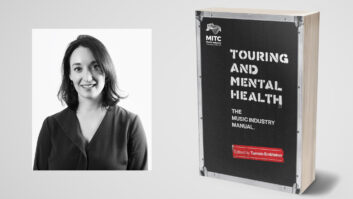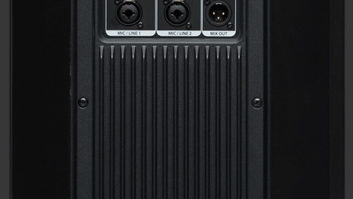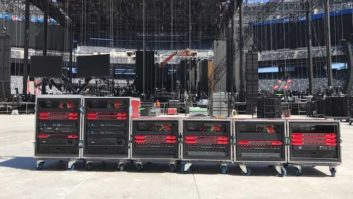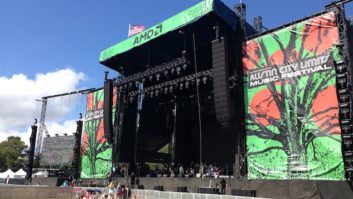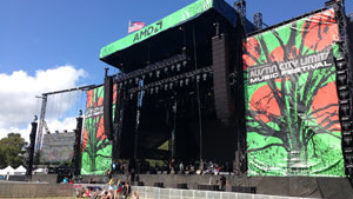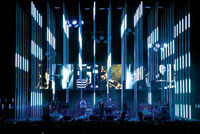
Photo: Donny Emerick
The members of Radiohead take environmental responsibility seriously. Following the release of their downloadable In Rainbows album, the band (Thom Yorke, vocals/guitar/piano/electronics; Jonny Greenwood, guitar; Ed O’Brien, guitar; Colin Greenwood, bass guitar/synths; and Phil Selway, drums) are reducing their carbon footprint while on the road, teaming up with a company called Best Foot Forward to track and decrease their emissions. One step they’ve taken is to reduce the amount of freightage for a world tour by creating dual systems for their U.S. leg (Firehouse Productions supplied control and gear) and their European dates (system spec’d by Wigwam Acoustics Ltd.).
“We’ve basically got two systems, which is common with almost everything else that’s happening on this tour,” explains front-of-house engineer Jim Warren, who began working with Radiohead before they were signed to Capitol in 1992. “They’ve got two different sets of backline: one on each side of the Atlantic. As far as my FOH setup, cosmetically it’s different since different companies do their patching and whatever, but fundamentally it’s the same system.”
Warren is mixing on a Digidesign VENUE board, using 70-odd inputs. “The way I run my desk is with a limiter across the mix or stereo bus that feeds the P.A. sends and the record feeds. Generally, that fader just sits at zero and the limiter gets me a decent level. But there are times in certain songs where I’ll just pull the master back 4 to 6 dB to do all the things I want to do without something going haywire. And I’d rather just mix it quieter and rely on the fact that the audience will realize they can’t hear it as well as they did and will actually become quieter themselves.”
Warren is usually only concerned with 24 to 30 channels, depending on the song, but relies on presets to simplify his mixing process. “You still mix, but it means that a lot of the drudge and the frantic activity is taken out,” he says. Warren also stresses reliability as a selling point for the board: “It’s the freedom to start in production rehearsals with the console and a set of plug-ins that you know will cover most everything. You are no longer phoning up the P.A. company every couple of days saying you need another compressor or reverb unit.
Warren is also managing a Pro Tools HD system for multitracking the shows and will use it if the band’s not around for soundcheck to help set up the system for that night’s show.
While reliability in a console is key to a successful tour, Warren took a chance and brought out a relatively unknown P.A.; the second leg of the U.S. tour saw the international debut of the brand-new L-Acoustics K1/KUDO line array system. He was willing to try out the rig based on a recommendation from his previous and current systems engineers who have relationships with the European manufacturer. “[I brought it on tour] after getting a few assurances from them on how well-tested it was. We’ve got three gigs on it so far, and the results have been good,” he reports.
Administered by system engineer Sherif El Barbari, the U.S package includes two 16 K1s, 2x eight K1-subs (flown), 2x three dV-DOSC underhangs and 2x nine KUDOs for side P.A. Ground subs are 16 SB 28s, and front-fills include six Firehouse custom-built cabinets with TAD high ends. Controller amps are 12 LA8 RAKs with three LA8s each driving the P.A., with the exception of front-fills, which are powered by Crown IT 6000s.
El Barbari uses LA network manager software for remote-controlling and monitoring the controller amps, and three Dolby Lake Processors for zoning and EQ. Stage tech Ross Anderson and Firehouse systems techs Tim Fraleigh, Jamie Pollock and Charlie Cambell support him on the U.S. tour.
“It was very comfortable and an easy transition,” says Warren. “If anything, it has a slightly better top end, but the big improvement they’ve made is in terms of the rigging and controlling the low frequencies as well as how they’ve always been able to control the highs and the high-mids.”
Creating the Sound
Working with Radiohead since 2000, monitor engineer Graham Lees is also mixing on a Digidesign VENUE, working 20 mixes for the performers and techs onstage. “I don’t use snapshots; I ride the faders continuously,” Lees says. “I’ve got presets with notes to remind me, but everything is open.”
He is sending much more information into their in-ears as “they trust me to put in things I didn’t originally do,” he says. “They never wanted most keyboard sounds in their in-ears and only in the wedges. Now, it’s in both. Sometimes I just did it and it was accepted.” Yorke, O’Brien and Selway are on in-ears; Jonny Greenwood and Colin Greenwood rely solely on wedges.
For both Warren and Lees, the depth of sonic quality and construction of Radiohead’s seven studio albums has made it challenging to produce their live show in a way that reflects the sound of their recordings. “Its one of those things that’s hard to do as live sound engineer,” admits Warren, “because when people listen to a record and it sounds a certain way, they assume that it’s meant to sound like that. You expect that after two years doing this record, they didn’t accidentally put too much reverb on the vocal. And yet when you’re doing it live, if the vocal is soaked in reverb and buried right into the mix, you want to try and bring it out because it feels like it’s wrong.
“So I’ve tried to be as bloody-minded as the band is sometimes in their sonic construction,” Warren concludes. “There’s a few bits and pieces where I’ve gone beyond the realms of good taste, which is what the band frequently does anyway. And you’ve got to hope it balances out over the night. It’s about having the courage of your convictions and having die-hard fans that are very familiar with the records appreciate things sounding as strangely deranged as they are on the records.”
Donny Emerick is a writer in Rhode Island.
Select Mics
Vocals: Shure 87C
Upright Piano: MIDI, Helpinstill pick-up, Shure WL50 suspended from the lid.
Fender Rhodes: Shure SM57
Guitars: Audio-Technica AT3050
Glockenspiel: Two Y-split Shure MC50B
Drums: Beyer M201 (snare side), Sennheiser 504 (snare top), ATM 350
